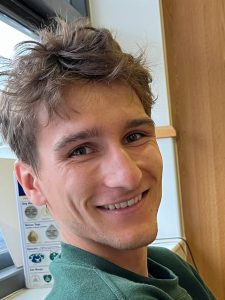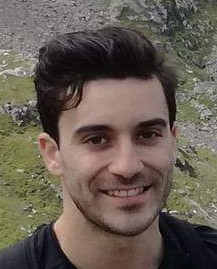Current Research Highlights
The Nuclear Waste Services Research Support Office works with PhD students at all stages of their research.
Below, you can find out more from some of the current and former NWS sponsored researchers.
2022 PhD Research Cohort
Arij Asad
 Ventilation of Hydrogen in UILW Vaults
Ventilation of Hydrogen in UILW Vaults
University of Bristol
Hydrogen can be generated by corrosion processes in certain types of radioactive waste package. Hydrogen is flammable and hence mitigating measures – such as mechanical ventilation – must be considered to ensure the safe storage of packages. For a GDF, NWS has identified that the most challenging scenario for hydrogen is for unshielded intermediate level waste (UILW) packages. It may be possible to improve the current GDF ventilation concept design by carrying out detailed modelling of how hydrogen releases and then disperses within UILW vaults: this is the purpose of the project. We will approach this problem using analytical methods and computational modelling, along with some supporting experimental work. We will use point source buoyancy plume theory for hydrogen leakage, in conjunction with modelling of the confined space restrictions. The NWS RSO PhD call project will investigate the influence of numerous parameters (e.g., ventilation locations, airflow values, package stacking arrangements), to aim to make recommendations for how ventilation can be optimised. We will also carry out modelling of a distributed hydrogen sensor within an UILW vault, to determine if it is feasible for such a network to ‘pin point’ the location of high concentrations of hydrogen.
Abdelrazik Elfar
 Machine learning methodologies for optimised gas transport characterisation
Machine learning methodologies for optimised gas transport characterisation
University of Manchester
Corrosion, organic degradation, radioactive decay and radiolysis associated with waste in the Geological Disposal Facility will generate radioactive and ‘bulk’ gases. Most bulk gas will be hydrogen, acting as a ‘carrier’ for radioactive gases. Hydrogen generation will trigger a complex flow problem where hydrogen migrates in water-saturated heterogeneous clay pore space. Different physical processes will occur, such as diffusion, uptake or adsorption of the gas on rock surface, as well as interactions with clay host rock. Additionally, clays feature extensive levels of mineralogical and physical (pore space) heterogeneity. Existing literature has shown that experiments and two-phase flow modelling (based on classical numerical methods) of these processes are difficult and computationally expensive, posing challenges to characterisation of gas transport behaviour. Towards addressing these issues, this project proposes to apply deep learning workflows towards advanced pore-scale characterisation techniques and accelerated two-phase gas transport modelling. Models will be trained upon stochastic databases for clay rock features (generated using machine learning and pattern recognition), classical pore network modelling and 4D imaging of pore-scale experiments.
Alfie Hewetson
 Coastal Change
Coastal Change
Imperial College London
Coastal areas are constantly evolving. Even within a single year, tidal and wave forcing can lead to significant changes in the location of the shoreline and configuration of seabed. Recent climate projections indicate that changes in the mean sea-level, ocean circulation and storminess will have a profound effect on coastal dynamics in the longer term. This means that many areas will experience considerable geographical modifications. Such effects are already becoming apparent through increased rates of erosion and more frequent occurrences of coastal flooding. The purpose of the present project is to develop methodologies appropriate to the description of coastal evolution under a changing climate around the UK. This will be achieved by a combination of improved physical understanding of the coastal system and advanced statistical and numerical techniques. In integrating the detailed modelling of coastal processes into long term climate prediction, the research outcomes will provide the necessary tools to predict coastal change in time scales ranging from 100s to 100,000s years. This information will provide critical insights regarding the selection and assessment of coastal sites as a potential location for the UK Geological Disposal Facility and will provide a sound basis for assessing related safety in the very long term.
Samuel Jones
 Lithological control on the gas transport properties of the Mercia Mudstone Group
Lithological control on the gas transport properties of the Mercia Mudstone Group
University of Liverpool
Radiogenic and bulk gas migration from a Geological Disposal Facility (GDF) can happen in several ways, such as advectively via aqueous fluids, as a separate gas phase or via diffusion. Consequently, fluid movement associated with any GDF must be understood as part of a site selection process. The Mercia Mudstone Group (MMG) is a potential host rock for a UK GDF in the ongoing siting process; previous work at the University of Liverpool has shown its low permeability is related to primary sedimentology and diagenetic history. Clay-poor horizons have pores filled with diagenetic cement but have higher pore throat diameters and permeability than clay-rich horizons. Therefore, clay-rich horizons may represent a better prospect for siting a GDF, but permeability has not yet been extensively measured, nor the principal controls on fluid migration established. This studentship will establish a quantitative understanding of the controls of gas and water permeability under conditions that are directly representative of those predicted for the GDF. We will determine how stratigraphy, sedimentology, mineralogy, petrography, pressure and temperature histories affect the flow characteristics (porosity, pore throat diameter, and gas and water permeability) of the non-evaporitic Mercia Mudstone Group, providing a firm basis to understand the pathways for radiogenic gas migration from a GDF that will affect the stress and temperature conditions in the subsurface.
Sannah Van Balen
 Social Sciences. Risk and the perception of Risk
Social Sciences. Risk and the perception of Risk
University of Cambridge
There is no question that individuals are flawed at intuitive risk assessment. Risks related to radiation are particularly difficult since radiation is impossible to sense; it doesn’t have a smell, a taste, a sound, a texture, or a characterising appearance. Formal risk assessment techniques are used to support decision-making on risk mitigation at an institutional level. Risks are traditionally calculated using the probability of incidents occurring and the potential damage done, which are then compared to the mitigation cost. However, many risks are uncertain in outcome, probability, or both. It is therefore extremely challenging to base decisions solely on such bounded risk assessments. Instead, the decisions on how to deal with risks are heavily influenced by society’s perception. The perceived probabilities, costs, and harm can vary by many orders of magnitude from the actual ones and result in gross misallocation of resources as well as validate the perceived unsafe nature of nuclear energy and its waste management practices. This project investigates the influence of perception in risk assessment and management related to a geological disposal facility of radioactive waste in the UK.
2021 PhD Research Cohort
Rebecca Lindsey-Halls
 Effect of high temperatures on cement backfill (NRVB)
Effect of high temperatures on cement backfill (NRVB)
University of Strathclyde
My PhD aims to investigate and understand the effect on the chemical and physical properties of a potential backfill material (Nirex Reference Vault Backfill; NRVB) under exposure to the potential temperatures (>100 °C) and conditions that will be reached in disposal units housing High-Heat Generating Waste (HHGW) within a Geological Disposal Facility (GDF). The effect of adding silicon dioxide (SiO2), to increase backfill strength and lower the heat of hydration, is also being investigated under these temperatures and conditions. This includes analysing the differences in the mineralogy and water transport properties (e.g., porosity, permeability, sorptivity), and the effect these changes have on the properties of NRVB. This is being achieved using a range of analytical methods including X-ray Diffraction (XRD), X-ray Computed Tomography (XCT), Scanning Electron Microscopy (SEM), and Electron Probe Microanalysis (EPMA).
This research is key to understanding whether NRVB can potentially be used above 100°C as a substitute to the proposed bentonite backfill for HHGW. This is important in underpinning the safety case for deep geological disposal of radioactive waste.
Elise Mouat
 Managing LHGW-derived gas via innovative Engineered Barrier System (EBS) materials
Managing LHGW-derived gas via innovative Engineered Barrier System (EBS) materials
University of Edinburgh
The engineered barrier system (EBS) is a key component for GDF safety. The EBS helps to isolate the waste at depth and prevents radionuclides from being released into the environment. The EBS needs to be able to deal with gases that are produced during container corrosion and waste degradation, providing pore-space and passively controlling gas release to mitigate gas pressurisation of the GDF. This project explores re-use of excavated GDF material or waste rocks from quarries within the EBS. Their use as an EBS material would lower the environmental footprint and prevent these materials from filling landfills. We will assess whether, when mixed with bentonite, these materials could meet criteria for EBS usage, including mechanical strength, fluid/gas permeability, microbial activity for gas consumption and the long-term performance of these re-used materials.
Adwoa Owusu
 Hydrothermal treatment of cement backfill as a method for accelerated cement aging
Hydrothermal treatment of cement backfill as a method for accelerated cement aging
University of Leeds
Cement-based materials are currently used to encapsulate intermediate-level radioactive wastes and may also be used as an engineered backfill around such wastes within a deep geological disposal facility. Knowledge of how the phases in the hardened cements evolve with age is important for the development of predictive models for long-term performance. This project involves the hydrothermal treatment and characterization of (i) extant samples of the current candidate backfill material and of (ii) a synthetic analogue of the main phase that is present in that material. The preparation of the synthetic analogue follows a novel method developed in a previous project. (iii) old cement samples to provide more understanding on the changes that occur in cement with age. The characterization involves a number of sophisticated experimental techniques, including analytical transmission electron microscopy, powder X-ray diffraction, and solid-state nuclear magnetic resonance spectroscopy. This project does not involve any radioactive materials and some experimental work will be conducted at the laboratories of the British Geological Survey. The project is sponsored by Nuclear Waste Services.
Bethan Payne
 Microbial gas consumption processes in the GDF safety case for Low Heat Generating Wastes
Microbial gas consumption processes in the GDF safety case for Low Heat Generating Wastes
University of Edinburgh
A Geological Disposal Facility (GDF) will be designed to contain and limit the release of radionuclides to the environment over the long-term. As a result, understanding the environmental processes that could occur over the GDF’s life span, and the implications of these on containment, is critically important. During the operational and post-closure phases of the GDF, gases will be produced through corrosion of metals, radiolysis of groundwater, and microbial degradation of organic materials. Gas production may over-pressurise the GDF, posing a significant risk to Engineered Barrier System (EBS) integrity and providing release pathways for gaseous radionuclides. Gas consumption processes are expected to reduce the pressure of GDF gases through a series of complex microbial, chemical and physical reactions. This project aims to elucidate the role of microbial activity in consuming GDF gases and the subsequent impact on the containment function of GDF components. The implications of microbial gas consumption on long-term GDF performance will be assessed via a series of laboratory experiments and computer modelling.
Tom Ross
 Inducing the resumption of alteration in UK radioactive waste glasses
Inducing the resumption of alteration in UK radioactive waste glasses
University of Cambridge
The dissolution rate of radioactive waste glasses reduces by approximately a factor of one thousand over the first 1 – 28 days of contact with water. This reduction in dissolution rate, to what is known as the residual rate, is associated with a reduction in the thermodynamic driving force for dissolution (as solubility limits of certain glass components are approached and no more glass can be dissolved) and the protective effect on the glass surface of the formation of an altered layer that inhibits transport to and from the unaltered glass surface. A phenomenon that is occasionally observed at long time scales in international (and compositionally different) glass formulations is the resumption of glass dissolution at rates approaching the initial dissolution rate. This phenomenon is known as resumption of alteration and remains as a potential uncertainty in the long-term performance of radioactive waste glasses in a geological disposal facility. This research project will investigate the applicability of a resumption of alteration scenario for UK radioactive waste glasses. It will aim to determine the primary controls on any resumption, paying respect to compositional differences with international radioactive waste glasses.
2020 PhD Research Cohort
Jenny Ayling
 Understanding nuclear waste glass durability as a function of groundwater composition
Understanding nuclear waste glass durability as a function of groundwater composition
University of Sheffield
In the UK, the by-products from spent nuclear fuel reprocessing are vitrified to form a glassy wasteform that will be disposed of in a geological disposal facility deep underground. During the operational lifetime of the geological disposal facility, groundwater may ingress into the facility and interact with the vitrified waste leading to leaching of the glass. The rate of this dissolution is expected to be influenced by elements dissolved in the groundwater.
My project investigates the effect of dissolved alkali metal and alkaline earth cations on the rate of dissolution of a non-active simulant version of a UK high level waste glass, known as MW25. I am examining the initial rate and residual rate through a combination of dynamic Single Pass Flow Through (SPFT) and static Materials Centre Characterisation (MCC-1) methodologies. The effect of the dissolved elements is studied through chemical analysis of the solutions and SEM/EDS of the altered glass.
Kristof Bartha
 Potential Role Of Digital Twins In Seeking Consensus For GDF Siting
Potential Role Of Digital Twins In Seeking Consensus For GDF Siting
University of Manchester
The process for siting a Geological Disposal Facility (GDF) in the UK is set out in the Working with Communities policy. The process of working with communities, will enable communities to engage in the process with confidence. Digital twins are being used increasingly by designers to develop what is called “optimised design” of significant nuclear infrastructure projects. Digital twins are computational representations of individual physical systems that can be used to inform all phases of a typical plant lifecycle. Scientists and engineers recognise that the successful implementation of virtual reality will require new ways to gather, process and share increasingly large volumes of data. The aim of this project is to assess the contribution digital twins could make to the provision of clear, evidence-based information to all stakeholders in the GDF and also how they might be employed within the consent-based process to enhance public confidence.
Sam Clarke
 Gas movement in halite
Gas movement in halite
University of Cambridge
Halite, a type of rock made up mostly of crystallised NaCl, is a good potential host rock for a GDF. Its low permeability and porosity prevent the flow of water and gas into and out of a repository, making it an excellent natural barrier. Its high creep rate allows fractures to reseal on much shorter timescales than other rocks, and its properties are well understood by mining engineers. Its high solubility, however, presents unique challenges. My research looks at how water might dissolve the rock, and whether this creates pathways for waste material to leave the repository. In particular, I am focussing on two scenarios:
i) Pore water moving down a pressure gradient towards a mined opening dissolves different halite minerals such as sylvite (KCl), changing its density relative to the formation fluid
ii) Heat-generating waste in the repository causes the pore water to get hotter, increasing the amount of salt it can hold in solution and dissolving the halite.
I use simple physical experiments to probe the phenomenology of these scenarios and create models to describe them mathematically, which can show whether they are relevant for consideration in a safety case.
Gonҫalo Cunha
 Coupled process modelling (THM)
Coupled process modelling (THM)
University of Edinburgh
The PhD project focuses on making developments in the fields of coupled THMC (thermal, hydrological, mechanical and chemical) processes and how these affect rock fractures’ behaviours in the subsurface.
Fractures are empty spaces (surfaces) within rock masses that promote fluid flow. They are of particular interest in rocks that have very low because they become the only avenue for fluid flow. This is important for RWM because GDFs are designed in these impermeable rocks to contain fluid flow within the gallery and not out the GDF.
More specifically, the project focuses on developing a new method to characterise fracture surfaces and the empty space between them (aperture) using spatial continuity mathematical methods. This allows to upscale fracture roughness and apertures distributions in a way that conserves the statistics whilst providing control over the model’s point density. It may also allow for finding the Representative Elementary Volume (REV) as well as modelling larger fractures where data is not available. This is followed by modelling aperture distribution evolution after shear displacement of a fracture surface over the other making use of the spatial continuity statistics.
Max Rose
 A numerical approach to evaluating uncertainty associated with microbial activity in near-field systems
A numerical approach to evaluating uncertainty associated with microbial activity in near-field systems
University of Manchester
My project looks at microbial activity in and around the bentonite buffer in a GDF. Bentonites naturally contain sulfate-reducing bacteria (SRB), which in the presence of the correct substrates, have metabolisms capable of a number of functions. Key nutrients for SRB activity are present in a GDF. Sulfate, the electron acceptor, is present in most groundwaters, and abiotic corrosion of steel produces hydrogen, which is an electron donor. On one hand, a by-product of sulfate-reducing metabolism is H2S, which is highly corrosive to metals, but on the other hand SRB are also capable of metabolising and reducing concentrations of important radionuclides in groundwater to insoluble phases.
In a compacted bentonite buffer swelling pressures cause a sufficient reduction in porosity to restrict microbial activity, constraining any potential microbial activity to interface locations, such as between the bentonite buffer and the waste-containing canister. In different geochemical environments, this effect may become more or less pronounced, and one area which is important to my research is the degree to which salinity will affect microbial activity in a compacted bentonite buffer. I am also looking at the effects of the given conditions on important radionuclide metabolism by bacteria, and microbially-influenced corrosion rates of canister materials.
Rosie Smart
 An investigation of metallic uranium corrosion in a GDF setting
An investigation of metallic uranium corrosion in a GDF setting
University of Bristol
Despite the very first generation of commercial nuclear power reactors now being retired, we still need to dispose of the inventory of the spent nuclear fuel. For decades spent fuel has been held in interim storage facilities, requiring frequent maintenance and monitoring. Much of this nuclear waste will remain radioactive for thousands of years. It is therefore naive and arguably unethical to rely on future generations to carry the burden of continuing to store this waste safety and effectively.
In England and Wales the accepted solution is to construct a geological disposal facility deep underground. Such a facility will aim to isolate nuclear waste for hundreds of thousands of years, by which time the radioactive waste will have decayed to safe background levels of radioactivity.
My PhD aims to investigate how uranium, used in nuclear fuel, would corrode and behave over thousands of years and under the evolving conditions of a geological disposal facility, for example in different types of groundwater and oxygen concentration. Uranium corrosion is important to investigate to ensure the safety of a disposal facility, both in the short- and long-term. We need to be confident that radioactive uranium corrosion products do not seep into the groundwater and escape the facility, and that toxic corrosion products do not form in a way in which endangers the safety of the facility.
Contact us
We welcome opportunities to connect with the research community, industry and the general public.



